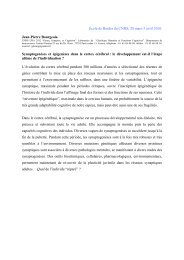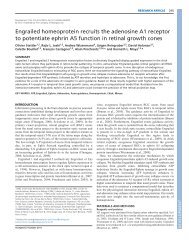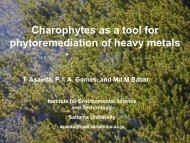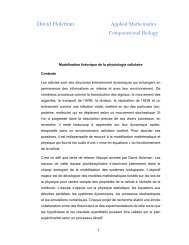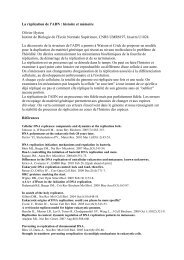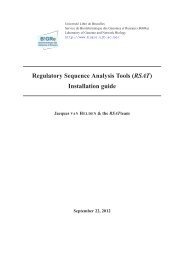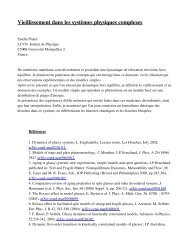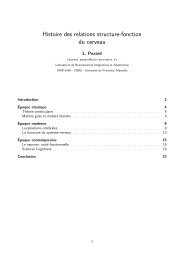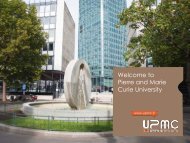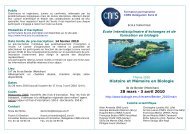Diet and the evolution of human amylase gene copy number variation
Diet and the evolution of human amylase gene copy number variation
Diet and the evolution of human amylase gene copy number variation
You also want an ePaper? Increase the reach of your titles
YUMPU automatically turns print PDFs into web optimized ePapers that Google loves.
L E T T E R S<br />
© 2007 Nature Publishing Group http://www.nature.com/nature<strong>gene</strong>tics<br />
<strong>Diet</strong> <strong>and</strong> <strong>the</strong> <strong>evolution</strong> <strong>of</strong> <strong>human</strong> <strong>amylase</strong> <strong>gene</strong> <strong>copy</strong><br />
<strong>number</strong> <strong>variation</strong><br />
George H Perry 1,2 , Nathaniel J Dominy 3 , Katrina G Claw 1,4 , Arthur S Lee 2 , Heike Fiegler 5 , Richard Redon 5 ,<br />
John Werner 4 , Fern<strong>and</strong>o A Villanea 3 , Joanna L Mountain 6 , Rajeev Misra 4 , Nigel P Carter 5 , Charles Lee 2,7,8 &<br />
Anne C Stone 1,8<br />
Starch consumption is a prominent characteristic <strong>of</strong><br />
agricultural societies <strong>and</strong> hunter-ga<strong>the</strong>rers in arid<br />
environments. In contrast, rainforest <strong>and</strong> circum-arctic hunterga<strong>the</strong>rers<br />
<strong>and</strong> some pastoralists consume much less starch 1–3 .<br />
This behavioral <strong>variation</strong> raises <strong>the</strong> possibility that different<br />
selective pressures have acted on <strong>amylase</strong>, <strong>the</strong> enzyme<br />
responsible for starch hydrolysis 4 . We found that <strong>copy</strong> <strong>number</strong><br />
<strong>of</strong> <strong>the</strong> salivary <strong>amylase</strong> <strong>gene</strong> (AMY1) is correlated positively<br />
with salivary <strong>amylase</strong> protein level <strong>and</strong> that individuals from<br />
populations with high-starch diets have, on average, more<br />
AMY1 copies than those with traditionally low-starch diets.<br />
Comparisons with o<strong>the</strong>r loci in a subset <strong>of</strong> <strong>the</strong>se populations<br />
suggest that <strong>the</strong> extent <strong>of</strong> AMY1 <strong>copy</strong> <strong>number</strong> differentiation is<br />
highly unusual. This example <strong>of</strong> positive selection on a <strong>copy</strong><br />
<strong>number</strong>–variable <strong>gene</strong> is, to our knowledge, one <strong>of</strong> <strong>the</strong> first<br />
discovered in <strong>the</strong> <strong>human</strong> genome. Higher AMY1 <strong>copy</strong> <strong>number</strong>s<br />
<strong>and</strong> protein levels probably improve <strong>the</strong> digestion <strong>of</strong> starchy<br />
foods <strong>and</strong> may buffer against <strong>the</strong> fitness-reducing effects<br />
<strong>of</strong> intestinal disease.<br />
Hominin <strong>evolution</strong> is characterized by significant dietary shifts,<br />
facilitated in part by <strong>the</strong> development <strong>of</strong> stone tool technology,<br />
<strong>the</strong> control <strong>of</strong> fire <strong>and</strong>, most recently, <strong>the</strong> domestication <strong>of</strong> plants<br />
<strong>and</strong> animals 5–7 . Starch, for instance, has become an increasingly<br />
prominent component <strong>of</strong> <strong>the</strong> <strong>human</strong> diet, particularly among<br />
agricultural societies 8 . It st<strong>and</strong>s to reason, <strong>the</strong>refore, that studies <strong>of</strong><br />
<strong>the</strong> <strong>evolution</strong> <strong>of</strong> <strong>amylase</strong> in <strong>human</strong>s <strong>and</strong> our close primate relatives<br />
may provide insight into our ecological history. Because <strong>the</strong> <strong>human</strong><br />
salivary <strong>amylase</strong> <strong>gene</strong> (AMY1) shows extensive <strong>variation</strong> in <strong>copy</strong><br />
<strong>number</strong> 9,10 , we first assessed whe<strong>the</strong>r a functional relationship exists<br />
between AMY1 <strong>copy</strong> <strong>number</strong> <strong>and</strong> <strong>the</strong> amount <strong>of</strong> <strong>amylase</strong> protein<br />
in saliva. We <strong>the</strong>n determined if AMY1 <strong>copy</strong> <strong>number</strong> differs<br />
among modern <strong>human</strong> populations with contrasting amounts <strong>of</strong><br />
dietary starch.<br />
We estimated diploid AMY1 <strong>gene</strong> <strong>copy</strong> <strong>number</strong> for 50 European<br />
Americans using an AMY1-specific real-time quantitative PCR<br />
(qPCR) assay. We observed extensive <strong>variation</strong> in AMY1 <strong>copy</strong> <strong>number</strong><br />
in this population sample (Fig. 1a <strong>and</strong> Supplementary Table 1<br />
online), consistent with previous studies 10,11 . Next, we performed<br />
protein blot experiments with saliva samples from <strong>the</strong> same individuals<br />
in order to estimate salivary <strong>amylase</strong> protein levels (Fig. 1b).<br />
These experiments showed a significant positive correlation between<br />
salivary <strong>amylase</strong> <strong>gene</strong> <strong>copy</strong> <strong>number</strong> <strong>and</strong> protein expression (P o<br />
0.001; Fig. 1c).<br />
a<br />
AMY1 diploid <strong>copy</strong> <strong>number</strong><br />
b<br />
12<br />
10<br />
8<br />
6<br />
4<br />
2<br />
0<br />
c<br />
mg AMY1 protein / ml saliva<br />
7<br />
6<br />
5<br />
4<br />
3<br />
2<br />
1<br />
0<br />
0 2 4 6 8 10 12 14 16<br />
AMY1 diploid <strong>gene</strong> <strong>copy</strong> <strong>number</strong><br />
Figure 1 AMY1 <strong>copy</strong> <strong>number</strong> <strong>variation</strong> <strong>and</strong> salivary <strong>amylase</strong> protein<br />
expression. (a,b) For <strong>the</strong> same European American individuals,<br />
we estimated diploid AMY1 <strong>gene</strong> <strong>copy</strong> <strong>number</strong> with qPCR (a) <strong>and</strong><br />
estimated <strong>amylase</strong> protein levels in saliva by protein blot (b). Error bars<br />
indicate s.d. (c) Relationship between AMY1 diploid <strong>copy</strong> <strong>number</strong> <strong>and</strong><br />
salivary <strong>amylase</strong> protein level (n ¼ 50 European Americans). A considerable<br />
amount <strong>of</strong> <strong>variation</strong> in AMY1 protein expression is not explained by <strong>copy</strong><br />
<strong>number</strong> (R 2 ¼ 0.351), which may reflect o<strong>the</strong>r <strong>gene</strong>tic influences on<br />
AMY1 expression, such as regulatory region SNPs or non<strong>gene</strong>tic factors<br />
that may include individual hydration status, stress level <strong>and</strong> short-term<br />
dietary habits.<br />
1 School <strong>of</strong> Human Evolution <strong>and</strong> Social Change, Arizona State University, Tempe, Arizona 85287, USA. 2 Department <strong>of</strong> Pathology, Brigham <strong>and</strong> Women’s Hospital,<br />
Boston, Massachusetts 02115, USA. 3 Department <strong>of</strong> Anthropology, University <strong>of</strong> California, Santa Cruz, California 95064, USA. 4 School <strong>of</strong> Life Sciences, Arizona<br />
State University, Tempe, Arizona 85287, USA. 5 The Wellcome Trust Sanger Institute, The Wellcome Trust Genome Campus, Hinxton, Cambridge CB10 1SA, UK.<br />
6 Department <strong>of</strong> Anthropological Sciences, Stanford University, Stanford, California 94305, USA. 7 Harvard Medical School, Boston, Massachusetts 02115, USA.<br />
8 These authors contributed equally to this work. Correspondence should be addressed to N.J.D. (njdominy@ucsc.edu).<br />
Received 9 May; accepted 3 August; published online 9 September 2007; doi:10.1038/ng2123<br />
1 2 5 6 VOLUME 39 [ NUMBER 10 [ OCTOBER 2007 NATURE GENETICS
L E T T E R S<br />
© 2007 Nature Publishing Group http://www.nature.com/nature<strong>gene</strong>tics<br />
a<br />
Proportion <strong>of</strong> individuals<br />
b<br />
Cumulative proportion <strong>of</strong> individuals<br />
0.30<br />
0.25<br />
0.20<br />
0.15<br />
0.10<br />
0.05<br />
0.00<br />
1.0<br />
0.8<br />
0.6<br />
0.4<br />
0.2<br />
0.0<br />
2<br />
High starch<br />
Low starch<br />
Median<br />
3 4 5 6 7 8 9 10 11 12 13 14 15<br />
AMY1 diploid <strong>gene</strong> <strong>copy</strong> <strong>number</strong><br />
Although <strong>the</strong>re is a considerable range <strong>of</strong> <strong>variation</strong> in dietary starch<br />
intake among <strong>human</strong> populations, a distinction can be made between<br />
‘high-starch’ populations for which starchy food resources comprise a<br />
substantial portion <strong>of</strong> <strong>the</strong> diet <strong>and</strong> <strong>the</strong> small fraction <strong>of</strong> ‘low-starch’<br />
populations with traditional diets that incorporate relatively few<br />
starchy foods. Such diets instead emphasize proteinaceous resources<br />
(for example, meats <strong>and</strong> blood) <strong>and</strong> simple saccharides (for example,<br />
from fruit, honey <strong>and</strong> milk). To determine if AMY1 <strong>copy</strong> <strong>number</strong><br />
differs among populations with high- <strong>and</strong> low-starch diets, we<br />
estimated AMY1 <strong>copy</strong> <strong>number</strong> in three high-starch <strong>and</strong> four lowstarch<br />
population samples. Our high-starch sample included two<br />
agricultural populations, European Americans (n ¼ 50) <strong>and</strong> Japanese<br />
(n ¼ 45), <strong>and</strong> Hadza hunter-ga<strong>the</strong>rers who rely extensively on starchrich<br />
roots <strong>and</strong> tubers (n ¼ 38) 12 . Low-starch populations included<br />
Biaka (n ¼ 36) <strong>and</strong> Mbuti (n ¼ 15) rainforest hunter-ga<strong>the</strong>rers, Datog<br />
pastoralists (n ¼ 17) <strong>and</strong> <strong>the</strong> Yakut, a pastoralist, fishing society (n ¼<br />
25). Additional details on <strong>the</strong> diets <strong>of</strong> <strong>the</strong>se populations are provided<br />
in Supplementary Table 2 online. We found that mean diploid AMY1<br />
<strong>copy</strong> <strong>number</strong> was greater in high-starch populations (Fig. 2 <strong>and</strong><br />
N<br />
133<br />
93<br />
7<br />
5<br />
Mean<br />
6.72<br />
5.44<br />
s.d.<br />
2.35<br />
2.04<br />
High starch<br />
Japanese<br />
Low starch<br />
Hadza<br />
European<br />
American<br />
Biaka<br />
Mbuti<br />
Datog<br />
Yakut<br />
2 3 4 5 6 7 8 9 10<br />
AMY1 diploid <strong>gene</strong> <strong>copy</strong> <strong>number</strong><br />
Figure 2 <strong>Diet</strong> <strong>and</strong> AMY1 <strong>copy</strong> <strong>number</strong> <strong>variation</strong>. (a) Comparison <strong>of</strong> qPCRestimated<br />
AMY1 diploid <strong>copy</strong> <strong>number</strong> frequency distributions for populations<br />
with traditional diets that incorporate many starch-rich foods (high-starch)<br />
<strong>and</strong> populations with traditional diets that include little or no starch (lowstarch).<br />
(b) Cumulative distribution plot <strong>of</strong> diploid AMY1 <strong>copy</strong> <strong>number</strong> for<br />
each <strong>of</strong> <strong>the</strong> seven populations in <strong>the</strong> study.<br />
Supplementary Fig. 1 online). Notably, <strong>the</strong> proportion <strong>of</strong> individuals<br />
from <strong>the</strong> combined high-starch sample with at least six AMY1 copies<br />
(70%) was nearly two times greater than that for low-starch populations<br />
(37%). To visualize <strong>the</strong> allele-specific <strong>number</strong> <strong>and</strong> orientation <strong>of</strong><br />
AMY1 <strong>gene</strong> copies, we performed high-resolution FISH on stretched<br />
DNA fibers (fiber FISH); <strong>the</strong>se results were consistent with diploid<br />
AMY1 <strong>copy</strong> <strong>number</strong> estimates from our qPCR experiments (Fig. 3).<br />
The among-population patterns <strong>of</strong> AMY1 <strong>copy</strong> <strong>number</strong> <strong>variation</strong><br />
do not fit expectations under a simple geographical region–based<br />
model <strong>of</strong> <strong>gene</strong>tic drift: our high- <strong>and</strong> low-starch samples include both<br />
African <strong>and</strong> Asian populations, suggesting that diet more strongly<br />
predicts AMY1 <strong>copy</strong> <strong>number</strong> than geographic proximity. Based on this<br />
observation, we hypo<strong>the</strong>sized that natural selection may have influenced<br />
AMY1 <strong>copy</strong> <strong>number</strong> in certain <strong>human</strong> populations. However,<br />
we cannot rigorously test such a hypo<strong>the</strong>sis on <strong>the</strong> basis <strong>of</strong> our qPCR<br />
results alone, in part because we lack comparative data from o<strong>the</strong>r<br />
loci. Therefore, we next performed array-based comparative genomic<br />
hybridization (aCGH) on <strong>the</strong> Yakut population sample with a wholegenome<br />
tile path (WGTP) array platform that was previously used 11<br />
to describe genome-wide patterns <strong>of</strong> <strong>copy</strong> <strong>number</strong> <strong>variation</strong> in 270<br />
individuals (<strong>the</strong> HapMap collection), including <strong>the</strong> same Japanese<br />
population sample as in our study. For <strong>the</strong> Yakut aCGH experiments,<br />
we used <strong>the</strong> same reference DNA sample (NA10851) as in <strong>the</strong> previous<br />
study 11 , facilitating comparisons <strong>of</strong> Japanese <strong>and</strong> Yakut relative<br />
intensity log 2 ratios for <strong>the</strong> 26,574 BAC clones on <strong>the</strong> array, including<br />
two clones mapped to <strong>the</strong> AMY1 locus.<br />
a<br />
b<br />
Figure 3 High-resolution fiber FISH validation <strong>of</strong> AMY1 <strong>copy</strong> <strong>number</strong><br />
estimates. Red (B10 kb) <strong>and</strong> green (B8 kb) probes encompass <strong>the</strong> entire<br />
AMY1 <strong>gene</strong> <strong>and</strong> a retrotransposon directly upstream <strong>of</strong> (<strong>and</strong> unique to)<br />
AMY1, respectively. (a) Japanese individual GM18972 was estimated by<br />
qPCR to have 14 (13.73 ± 0.93) diploid AMY1 <strong>gene</strong> copies, consistent with<br />
fiber FISH results showing one allele with ten copies <strong>and</strong> <strong>the</strong> o<strong>the</strong>r with four<br />
copies. (b) Biaka individual GM10472 was estimated by qPCR to have six<br />
(6.11 ± 0.17) diploid AMY1 <strong>gene</strong> copies, consistent with fiber FISH results.<br />
(c) The reference chimpanzee (Clint; S006006) was confirmed to have two<br />
diploid AMY1 <strong>gene</strong> copies.<br />
c<br />
NATURE GENETICS VOLUME 39 [ NUMBER 10 [ OCTOBER 2007 1 2 5 7
L E T T E R S<br />
© 2007 Nature Publishing Group http://www.nature.com/nature<strong>gene</strong>tics<br />
Results from <strong>the</strong> two AMY1-mapped clones on <strong>the</strong> WGTP array<br />
supported our original observations: <strong>the</strong> log 2 ratios were strongly<br />
correlated with <strong>the</strong> qPCR estimates <strong>of</strong> AMY1 diploid <strong>copy</strong> <strong>number</strong><br />
(Supplementary Fig. 1), <strong>and</strong> <strong>the</strong> population mean log 2 ratios for both<br />
clones were greater for <strong>the</strong> Japanese sample (Fig. 4a <strong>and</strong> Supplementary<br />
Fig. 1). More importantly, with <strong>the</strong> WGTP data, we were able to<br />
compare <strong>the</strong> extent <strong>of</strong> population differentiation at <strong>the</strong> AMY1 locus to<br />
o<strong>the</strong>r loci in <strong>the</strong> genome for <strong>the</strong> two Asian population samples in our<br />
study. We would expect <strong>the</strong> magnitude <strong>and</strong> direction <strong>of</strong> <strong>the</strong> Japanese-<br />
Yakut mean log 2 ratio difference for <strong>the</strong> AMY1-mapped clones to be<br />
similar to those for o<strong>the</strong>r <strong>copy</strong> <strong>number</strong>–variable clones, if <strong>the</strong>se CNVs<br />
have experienced similar <strong>evolution</strong>ary pressures. However, <strong>the</strong> two<br />
AMY1-mapped clones are significant outliers in this distribution<br />
(Fig. 4b <strong>and</strong> Supplementary Fig. 2 online), leading us to reject this<br />
null hypo<strong>the</strong>sis. In addition, we considered a database <strong>of</strong> genotypes for<br />
783 genome-wide microsatellites for <strong>the</strong> same Yakut individuals <strong>and</strong> a<br />
different Japanese population sample 13 , because microsatellite loci are<br />
usually multiallelic (as is <strong>the</strong> AMY1 locus). We found that <strong>the</strong> extent <strong>of</strong><br />
Japanese-Yakut differentiation at <strong>the</strong> AMY1 locus exceeded that for<br />
497% <strong>of</strong> <strong>the</strong> microsatellite loci (Supplementary Fig. 3 online).<br />
Although this result should be interpreted with caution because we<br />
do not know whe<strong>the</strong>r AMY1 <strong>copy</strong> <strong>number</strong> <strong>and</strong> microsatellite mutation<br />
rates <strong>and</strong> patterns are similar, this finding is consistent with our<br />
results from <strong>the</strong> WGTP comparison.<br />
These observations suggest that natural selection has shaped AMY1<br />
<strong>copy</strong> <strong>number</strong> <strong>variation</strong> in ei<strong>the</strong>r <strong>the</strong> Japanese or <strong>the</strong> Yakut or in both<br />
populations. We cannot fully test <strong>the</strong> null hypo<strong>the</strong>sis for <strong>the</strong> o<strong>the</strong>r<br />
high- <strong>and</strong> low-starch populations in our study, but <strong>the</strong> patterns <strong>of</strong><br />
<strong>copy</strong> <strong>number</strong> <strong>variation</strong> we observed in <strong>the</strong>se populations are similar to<br />
those for <strong>the</strong> Japanese <strong>and</strong> Yakut <strong>and</strong> thus may also reflect non-neutral<br />
<strong>evolution</strong>. We favor a model in which AMY1 <strong>copy</strong> <strong>number</strong> has been<br />
subject to positive or directional selection in at least some high-starch<br />
populations but has evolved neutrally (that is, through <strong>gene</strong>tic drift) in<br />
low-starch populations. Although it is possible that lower AMY1 <strong>gene</strong><br />
<strong>copy</strong> <strong>number</strong>s have been favored by selection in low-starch populations,<br />
such an interpretation is less plausible for <strong>the</strong> simple reason that<br />
excessive <strong>amylase</strong> production is unlikely to have a significant negative<br />
effect on fitness. Fur<strong>the</strong>rmore, several lines <strong>of</strong> evidence <strong>of</strong>fer mechanisms<br />
by which higher salivary <strong>amylase</strong> protein expression may confer a<br />
fitness advantage for individuals with a high-starch diet. First, a<br />
significant amount <strong>of</strong> starch digestion occurs in <strong>the</strong> mouth during<br />
mastication 14 . For example, blood glucose has been shown to be<br />
significantly higher when high-starch foods such as corn, rice <strong>and</strong><br />
potatoes (but not low-starch foods such as apples) are first chewed<br />
<strong>and</strong> <strong>the</strong>n swallowed, ra<strong>the</strong>r than swallowed directly 15 . In addition, it<br />
has been suggested that oral digestion <strong>of</strong> starch is critically important<br />
for energy absorption during episodes <strong>of</strong> diarrhea 4 . Diarrheal diseases<br />
can have a significant effect on fitness; for example, such diseases<br />
caused 15% <strong>of</strong> worldwide deaths among children younger than 5 years<br />
as recently as 2001 (ref. 16). Last, salivary <strong>amylase</strong> persists in <strong>the</strong><br />
stomach <strong>and</strong> intestines after swallowing 17 , <strong>the</strong>reby augmenting <strong>the</strong><br />
enzymatic activity <strong>of</strong> pancreatic <strong>amylase</strong> in <strong>the</strong> small intestine. Higher<br />
AMY1 <strong>copy</strong> <strong>number</strong> <strong>and</strong> a concomitant increase in salivary <strong>amylase</strong><br />
protein thus are likely to improve <strong>the</strong> efficiency with which highstarch<br />
foods are digested in <strong>the</strong> mouth, stomach <strong>and</strong> intestines <strong>and</strong><br />
may also buffer against <strong>the</strong> potential fitness-reducing effects <strong>of</strong><br />
intestinal disease.<br />
To underst<strong>and</strong> better <strong>the</strong> <strong>evolution</strong>ary context <strong>of</strong> <strong>human</strong><br />
AMY1 <strong>copy</strong> <strong>number</strong> <strong>variation</strong>, we analyzed patterns <strong>of</strong> AMY1 <strong>copy</strong><br />
<strong>number</strong> <strong>variation</strong> in chimpanzees (Pan troglodytes) <strong>and</strong> bonobos<br />
(Pan paniscus). In contrast to <strong>the</strong> extensive <strong>copy</strong> <strong>number</strong> <strong>variation</strong><br />
a<br />
Number <strong>of</strong> individuals<br />
b<br />
Yakut mean log 2 ratio<br />
9<br />
6<br />
3<br />
0<br />
6<br />
4<br />
2<br />
Japanese (n = 45; mean = 0.433; s.d. = 0.335)<br />
Yakut (n = 25; mean = 0.071; s.d. = 0.451)<br />
0<br />
–0.6 –0.3 0.0 0.3 0.6 0.9 1.2 1.5<br />
Chr1tp-6D2 log 2 ratio<br />
1.0<br />
0.5<br />
0.0<br />
–0.5<br />
–1.0<br />
–1.0 –0.5 0.0 0.5 1.0<br />
Japanese mean log 2 ratio<br />
Figure 4 Japanese-Yakut <strong>copy</strong> <strong>number</strong> differentiation at AMY1 versus<br />
o<strong>the</strong>r genome-wide loci. (a) Frequency distributions <strong>of</strong> WGTP aCGH relative<br />
intensity log 2 ratios from AMY1-mapped clone Chr1tp-6D2 for Japanese <strong>and</strong><br />
Yakut individuals. (b) Relationship between Japanese <strong>and</strong> Yakut mean log 2<br />
ratios for all autosomal WGTP clones that were <strong>copy</strong> <strong>number</strong> variable in both<br />
populations. AMY1-mapped clones Chr1tp-6D2 <strong>and</strong> Chr1tp-30C7 are<br />
depicted as filled red <strong>and</strong> blue circles, respectively.<br />
we observed in <strong>human</strong>s, each <strong>of</strong> 15 wild-born western chimpanzees<br />
(P. t. verus) showed evidence <strong>of</strong> only two diploid AMY1 copies (Fig. 3c<br />
<strong>and</strong> Supplementary Fig. 4 online), consistent with previous findings<br />
18–21 . Although we observed evidence <strong>of</strong> a gain in AMY1 <strong>copy</strong><br />
<strong>number</strong> in bonobos relative to chimpanzees (Supplementary Fig. 4),<br />
our sequence-based analyses suggest that each <strong>of</strong> <strong>the</strong>se AMY1 copies<br />
has a disrupted coding sequence <strong>and</strong> may be nonfunctional (Supplementary<br />
Fig. 5 online). Therefore, <strong>the</strong> average <strong>human</strong> has roughly<br />
three times more AMY1 copies than chimpanzees, <strong>and</strong> bonobos may<br />
not have salivary <strong>amylase</strong> at all. Outgroup comparisons with o<strong>the</strong>r<br />
great apes suggest that AMY1 <strong>copy</strong> <strong>number</strong> was probably gained in <strong>the</strong><br />
<strong>human</strong> lineage, ra<strong>the</strong>r than lost in chimpanzees 21,22 . Given that AMY1<br />
<strong>copy</strong> <strong>number</strong> is positively correlated with salivary <strong>amylase</strong> protein<br />
expression in <strong>human</strong>s, it st<strong>and</strong>s to reason that <strong>the</strong> <strong>human</strong>-specific<br />
increase in <strong>copy</strong> <strong>number</strong> may explain, at least in part, why salivary<br />
<strong>amylase</strong> protein levels are approximately six to eight times higher in<br />
<strong>human</strong>s than in chimpanzees 23 . These patterns are consistent with <strong>the</strong><br />
<strong>gene</strong>ral dietary characteristics <strong>of</strong> Pan <strong>and</strong> Homo; chimpanzees <strong>and</strong><br />
bonobos are predominantly frugivorous <strong>and</strong> ingest little starch relative<br />
to most <strong>human</strong> populations 24 .<br />
Among o<strong>the</strong>r primates, New World monkeys do not produce<br />
salivary <strong>amylase</strong> <strong>and</strong> tend to consume little starch, but cercopi<strong>the</strong>cines<br />
(a subfamily <strong>of</strong> Old World monkeys including macaques <strong>and</strong><br />
1 2 5 8 VOLUME 39 [ NUMBER 10 [ OCTOBER 2007 NATURE GENETICS
L E T T E R S<br />
© 2007 Nature Publishing Group http://www.nature.com/nature<strong>gene</strong>tics<br />
mangabeys) have relatively high salivary <strong>amylase</strong> expression, even<br />
compared to <strong>human</strong>s 23 . Although <strong>the</strong> <strong>gene</strong>tic mechanisms are<br />
unknown, this expression pattern may have evolved to facilitate<br />
<strong>the</strong> digestion <strong>of</strong> starchy foods (such as <strong>the</strong> seeds <strong>of</strong> unripe fruits)<br />
stowed in <strong>the</strong> cheek pouch, a trait that, among primates, is unique<br />
to cercopi<strong>the</strong>cines 25 .<br />
The initial <strong>human</strong>-specific increase in AMY1 <strong>copy</strong> <strong>number</strong> may<br />
have been coincident with a dietary shift early in hominin <strong>evolution</strong>ary<br />
history. For example, it is hypo<strong>the</strong>sized that starch-rich plant<br />
underground storage organs (USOs) such as bulbs, corms <strong>and</strong> tubers<br />
were a critical food resource for early hominins 26,27 . Changes in USO<br />
consumption may even have facilitated <strong>the</strong> initial emergence <strong>and</strong><br />
spread <strong>of</strong> Homo erectus out <strong>of</strong> Africa 5,28 . Yet such arguments are<br />
difficult to test, mainly because direct evidence for <strong>the</strong> use <strong>of</strong> USOs is<br />
difficult to obtain, particularly for more remote time periods. USOs<br />
<strong>the</strong>mselves are perishable, as are many <strong>of</strong> <strong>the</strong> tools used to collect <strong>and</strong><br />
process <strong>the</strong>m. Therefore, underst<strong>and</strong>ing <strong>the</strong> timing <strong>and</strong> nature <strong>of</strong> <strong>the</strong><br />
initial <strong>human</strong>-lineage AMY1 duplications may provide insight into<br />
our ecological <strong>and</strong> <strong>evolution</strong>ary history. The low amount <strong>of</strong> nucleotide<br />
sequence divergence among <strong>the</strong> three AMY1 <strong>gene</strong> copies found in <strong>the</strong><br />
<strong>human</strong> genome reference sequence (hg18; d ¼ 0.00011 to 0.00056)<br />
implies a relatively recent origin that may be within <strong>the</strong> time frame <strong>of</strong><br />
modern <strong>human</strong> origins (that is, within <strong>the</strong> last B200,000 years; based<br />
on <strong>human</strong>-chimpanzee AMY1 d ¼ 0.027 <strong>and</strong> using an estimate <strong>of</strong><br />
6 million years ago for divergence <strong>of</strong> <strong>the</strong> <strong>human</strong> <strong>and</strong> chimpanzee<br />
lineages). However, given <strong>the</strong> possibility for <strong>gene</strong> conversion, we do<br />
not necessarily consider this estimate to be reliable. The <strong>gene</strong>ration <strong>of</strong><br />
AMY1 sequences from multiple <strong>human</strong>s may ultimately help to shed<br />
light on this issue.<br />
In summary, we have shown that <strong>the</strong> pattern <strong>of</strong> <strong>variation</strong> in <strong>copy</strong><br />
<strong>number</strong> <strong>of</strong> <strong>the</strong> <strong>human</strong> AMY1 <strong>gene</strong> is consistent with a history <strong>of</strong> dietrelated<br />
selection pressures, demonstrating <strong>the</strong> importance <strong>of</strong> starchy<br />
foods in <strong>human</strong> <strong>evolution</strong>. Although <strong>the</strong> <strong>amylase</strong> locus is one <strong>of</strong><br />
<strong>the</strong> most variable in <strong>the</strong> <strong>human</strong> genome with regard to <strong>copy</strong><br />
<strong>number</strong> 10 , it is by no means unique; a recent genome-wide survey<br />
identified 1,447 <strong>copy</strong> <strong>number</strong>–variable regions among 270 phenotypically<br />
normal <strong>human</strong> individuals 11 , <strong>and</strong> many more such regions<br />
are likely to be discovered with advances in <strong>copy</strong> <strong>number</strong> <strong>variation</strong><br />
detection technology. It is reasonable to speculate that <strong>copy</strong> <strong>number</strong><br />
variants o<strong>the</strong>r than AMY1 are or have been subject to strong pressures<br />
<strong>of</strong> natural selection, particularly given <strong>the</strong>ir potential influence<br />
on transcriptional <strong>and</strong> translational levels (for example, see ref. 29).<br />
The characterization <strong>of</strong> <strong>copy</strong> <strong>number</strong> <strong>variation</strong> among <strong>human</strong>s <strong>and</strong><br />
between <strong>human</strong>s <strong>and</strong> o<strong>the</strong>r primates promises considerable insight<br />
into our <strong>evolution</strong>ary history.<br />
METHODS<br />
Samples. Buccal swabs <strong>and</strong> saliva were collected under informed consent from<br />
50 European Americans ages 18–30 (Arizona State University institutional<br />
review board (IRB) protocol <strong>number</strong> 0503002355). Saliva was collected for<br />
3 min from under <strong>the</strong> tongue. Buccal swabs were collected from <strong>the</strong> Hadza<br />
(n ¼ 38) <strong>and</strong> Datog (n ¼ 17) from Tanzania (Stanford University IRB protocol<br />
<strong>number</strong> 9798-414). Genomic DNA samples from <strong>the</strong> Biaka (Central African<br />
Republic; n ¼ 32), Mbuti (Democratic Republic <strong>of</strong> Congo; n ¼ 15) <strong>and</strong> Yakut<br />
(Siberia; n ¼ 25) are from <strong>the</strong> HGDP-CEPH Human Genome Diversity Cell<br />
Line Panel. Lymphoblastoid cell lines from 45 Japanese, 4 additional Biaka <strong>and</strong><br />
<strong>the</strong> donor for <strong>the</strong> chimpanzee genome sequence (Clint) were obtained from <strong>the</strong><br />
Coriell Institute for Medical Research. Whole blood samples were collected<br />
during routine veterinary examinations from chimpanzees <strong>and</strong> bonobos<br />
housed at various zoological <strong>and</strong> research facilities. Two additional bonobo<br />
samples were obtained from <strong>the</strong> Integrated Primate Biomaterials <strong>and</strong> Information<br />
Resource. DNA was isolated using st<strong>and</strong>ard methods.<br />
Copy <strong>number</strong> estimation. Primers for qPCR (Supplementary Table 3 online)<br />
were designed to be specific to AMY1 (that is, to have sequence mismatches<br />
with AMY2A <strong>and</strong> AMY2B) based on <strong>the</strong> <strong>human</strong> <strong>and</strong> chimpanzee reference<br />
genome sequences. A previous study reported a single (haploid) <strong>copy</strong> <strong>of</strong> AMY1<br />
for one chimpanzee 18 , <strong>and</strong> a recent analysis 19 did not find any evidence <strong>of</strong><br />
recent AMY1 duplication for Clint. We used fiber FISH to confirm that Clint<br />
has two diploid copies <strong>of</strong> AMY1 (Fig. 3c). Therefore, we were able to estimate<br />
diploid <strong>copy</strong> <strong>number</strong> based on relative AMY1 quantity for <strong>human</strong> DNA<br />
compared to a st<strong>and</strong>ard curve constructed from <strong>the</strong> DNA <strong>of</strong> Clint. A fragment<br />
from <strong>the</strong> TP53 <strong>gene</strong> was also amplified to adjust for DNA dilution quantity<br />
<strong>variation</strong>. Samples were run in triplicate <strong>and</strong> st<strong>and</strong>ards in duplicate. Experiments<br />
were performed <strong>and</strong> analyzed as described previously 20 .<br />
Protein blot analysis. Protein samples were prepared by solubilizing saliva<br />
samples in 2% SDS <strong>and</strong> heating at 100 1C for 5 min. These samples were<br />
analyzed on mini SDS-polyacrylamide gels <strong>and</strong> transferred to polyvinylidene<br />
difluoride (PVDF) membranes (Immobilon-Millipore). For quantification<br />
purposes, a <strong>human</strong> salivary <strong>amylase</strong> protein sample <strong>of</strong> known quantity (Sigma)<br />
was run on each gel, with 5 mL <strong>of</strong> saliva for each sample. After transfer,<br />
<strong>the</strong> membranes were incubated for 1.5 h with primary antibodies raised<br />
against <strong>human</strong> salivary <strong>amylase</strong> (Sigma). The membranes were washed <strong>and</strong><br />
goat anti-rabbit alkaline phosphatase–conjugated IgG secondary antibodies<br />
(Pierce) were added for 1 h. The membranes were exposed to ECF substrate<br />
(Amersham Biosciences) for 5 min <strong>and</strong> <strong>the</strong>n analyzed using a phosphorimager.<br />
Quantification <strong>of</strong> protein b<strong>and</strong>s was performed using ImageQuant s<strong>of</strong>tware<br />
(Molecular Dynamics).<br />
Fiber FISH. DNA fibers were prepared by gently lysing cultured lymphoblast<br />
cells with 300 ml Cell Lysis Buffer (Gentra Systems) per 5 million cells. 10 ml <strong>of</strong><br />
lysate was placed on a poly-L-lysine–coated slide (LabScientific) <strong>and</strong> mechanically<br />
stretched with <strong>the</strong> edge <strong>of</strong> a coverslip. After 30 s, 300 ml <strong>of</strong> 100% methanol<br />
was applied to fix <strong>the</strong> fibers. Slides were dried at 37 1C for 5 min <strong>and</strong> <strong>the</strong>n<br />
stored at room temperature (22–25 1C).<br />
PCR product probes were made from (i) <strong>the</strong> entire AMY1 <strong>gene</strong> itself<br />
(B10 kb; red in images) <strong>and</strong> (ii) <strong>the</strong> retrotransposon found directly upstream<br />
<strong>of</strong> all AMY1 copies but not <strong>of</strong> pancreatic <strong>amylase</strong> <strong>gene</strong>s or <strong>amylase</strong> pseudo<strong>gene</strong>s<br />
(B8 kb; green in images). The <strong>gene</strong> probe may not be specific to AMY1 under<br />
all hybridization conditions (AMY1 sequence divergence with AMY2A <strong>and</strong><br />
AMY2B ¼ 7.5% <strong>and</strong> 7.1%, respectively), but <strong>the</strong> upstream probe is. We used<br />
long-range PCR followed by nested PCR for each region (primers <strong>and</strong><br />
conditions are provided in Supplementary Table 3). PCR products were<br />
purified with DNA Clean <strong>and</strong> Concentrator columns (Zymo).<br />
For each nested PCR product, 750 ng was combined with 20 ml 2.5<br />
r<strong>and</strong>om primer (BioPrime aCGH Labeling Module, Invitrogen) in a total<br />
volume <strong>of</strong> 39 ml. Samples were incubated at 100 1C for 5 min <strong>and</strong> were <strong>the</strong>n<br />
placed on ice for 5 min. Next, 5 ml 10 dUTP <strong>and</strong> 1 ml Exo-Klenow Fragment<br />
(BioPrime Module) <strong>and</strong> ei<strong>the</strong>r 5 ml (5 nmol) Biotin-16-dUTP (Roche; <strong>gene</strong><br />
probe) or 5 ml (5 nmol) digoxigenin-11-dUTP (Roche; upstream probe) were<br />
added, <strong>and</strong> samples were incubated at 37 1C for 5 h. Labeled products were<br />
purified with Microcon Centrifugal Filter Devices (Millipore) using three<br />
washes <strong>of</strong> 300 ml 0.1 SSC, eluted with 50 ml H 2 O. For each 1 mg <strong>of</strong> labeled<br />
DNA, we added 10 mg <strong>human</strong> Cot-1 DNA (Invitrogen).<br />
For each experiment, 500 ng <strong>of</strong> labeled DNA from each <strong>of</strong> <strong>the</strong> nested PCR<br />
reactions was combined, lyophilized, reconstituted in 10 ml hybridization buffer<br />
(50% formamide, 20% dextran sulfate, 2 SSC) <strong>and</strong> added to <strong>the</strong> slide (18 <br />
18 mm cover glass; Fisher). Fibers <strong>and</strong> probes were denatured toge<strong>the</strong>r<br />
(95 1C for 3 min) <strong>and</strong> hybridized in a humidified chamber (37 1C for 40 h).<br />
The slide was washed in 0.5 SSC at 75 1C for 5 min followed by three washes<br />
in 1 PBS at room temperature (22–25 1C) for 2 min each. Next, fibers were<br />
incubated with 200 ml CAS Block (Zymed) <strong>and</strong> 10% (vol/vol) normal goat<br />
serum (Zymed) for 20 min at room temperature (22–25 1C) under a HybriSlip<br />
(Invitrogen). We used a three-step detection <strong>and</strong> amplification (with reagents<br />
in 200 ml CAS Block with 10% (vol/vol) normal goat serum). Each step was<br />
conducted for 30 min at room temperature under a HybriSlip followed by<br />
three washes in 1 PBS for 2 min each at room temperature (22–25 1C).<br />
Reagents were as follows for each step: step (i): 1:500 anti-digoxigeninfluorescein,<br />
Fab fragments (Roche) <strong>and</strong> 1:500 Strepavidin, Alexa Fluor 594<br />
NATURE GENETICS VOLUME 39 [ NUMBER 10 [ OCTOBER 2007 1 2 5 9
L E T T E R S<br />
© 2007 Nature Publishing Group http://www.nature.com/nature<strong>gene</strong>tics<br />
conjugate (Invitrogen); step (ii): 1:250 rabbit anti-FITC (Zymed) <strong>and</strong> 1:500<br />
biotinylated anti-streptavidin (Vector Laboratories); step (iii): 1:100 goat antirabbit<br />
IgG-FITC (Zymed) <strong>and</strong> 1:500 streptavidin, Alexa Fluor 594 conjugate.<br />
Images were captured on an Olympus BX51 fluorescent microscope with<br />
an Applied Imaging camera <strong>and</strong> were analyzed with Applied Imaging’s<br />
Genus s<strong>of</strong>tware.<br />
aCGH analysis. For aCGH experiments, we used a large-insert clone DNA<br />
microarray covering <strong>the</strong> <strong>human</strong> genome in tiling path resolution 30 . Test<br />
genomic DNA samples (from Yakut individuals) <strong>and</strong> reference genomic<br />
DNA samples (from NA10851) were labeled with Cy3-dCTP <strong>and</strong> Cy5-dCTP,<br />
respectively (NEN Life Science Products) <strong>and</strong> were cohybridized to <strong>the</strong> array.<br />
For each sample, a duplicate experiment was performed in dye-swap to reduce<br />
false-positive error rates. Labeling, hybridization, washes <strong>and</strong> analyses were<br />
performed as described 11,30 .<br />
Note: Supplementary information is available on <strong>the</strong> Nature Genetics website.<br />
ACKNOWLEDGMENTS<br />
We are grateful to all our study participants. We thank H. Cann <strong>and</strong> C. de Toma<br />
<strong>of</strong> <strong>the</strong> Fondation Jean Dausset (CEPH), <strong>the</strong> Cincinnati Zoo, <strong>the</strong> Lincoln Park<br />
Zoo, <strong>the</strong> New Iberia Research Center, <strong>the</strong> Primate Foundation <strong>of</strong> Arizona, <strong>the</strong><br />
Southwest Foundation for Biomedical Research, <strong>the</strong> Coriell Institute for Medical<br />
Research <strong>and</strong> <strong>the</strong> Integrated Primate Biomaterials <strong>and</strong> Information Resource for<br />
samples. C. Tyler-Smith <strong>and</strong> Y. Gilad provided comments on a previous version<br />
<strong>of</strong> <strong>the</strong> manuscript. We would also like to thank <strong>the</strong> Wellcome Trust Sanger<br />
Institute Microarray Facility for printing <strong>the</strong> arrays <strong>and</strong> T. Fitzgerald <strong>and</strong> D. Rajan<br />
for technical support. This study was funded by grants from <strong>the</strong> L.S.B. Leakey<br />
Foundation <strong>and</strong> Wenner-Gren Foundation (to N.J.D.), <strong>the</strong> Department <strong>of</strong><br />
Pathology, Brigham & Women’s Hospital (to C.L.), <strong>the</strong> National Institutes <strong>of</strong><br />
Health (to <strong>the</strong> University <strong>of</strong> Louisiana at Lafayette New Iberia Research Center;<br />
<strong>number</strong>s RR015087, RR014491 <strong>and</strong> RR016483) <strong>and</strong> <strong>the</strong> Wellcome Trust (H.F.,<br />
R.R. <strong>and</strong> N.P.C.).<br />
AUTHOR CONTRIBUTIONS<br />
G.H.P. <strong>and</strong> N.J.D. contributed equally to this work. G.H.P., N.J.D., C.L. <strong>and</strong><br />
A.C.S. designed <strong>the</strong> study; G.H.P., F.A.V., J.L.M. <strong>and</strong> A.C.S. collected <strong>the</strong> samples;<br />
G.H.P. <strong>and</strong> A.S.L. performed qPCR experiments; J.W. performed protein blot<br />
experiments; G.H.P. performed fiber FISH experiments; H.F. <strong>and</strong> R.R. performed<br />
<strong>and</strong> analyzed aCGH experiments; K.G.C. performed nucleotide sequencing<br />
experiments; G.H.P. performed data analyses; R.M., N.P.C., C.L. <strong>and</strong> A.C.S.<br />
supervised <strong>the</strong> experiments <strong>and</strong> analyses <strong>and</strong> G.H.P. <strong>and</strong> N.J.D. wrote <strong>the</strong> paper.<br />
Published online at http://www.nature.com/nature<strong>gene</strong>tics<br />
Reprints <strong>and</strong> permissions information is available online at http://npg.nature.com/<br />
reprints<strong>and</strong>permissions<br />
1. Tokarev, S.A. & Gurvich, I.S. The Yakuts. in Peoples <strong>of</strong> Siberia (eds. Levin, M.G. &<br />
Potapov, L.P.) 243–304 (University <strong>of</strong> Chicago Press, Chicago, 1956).<br />
2. Draper, H.H. The aboriginal Eskimo diet in modern perspective. Am. Anthropol. 79,<br />
309–316 (1977).<br />
3. Hart, T.B. & Hart, J.A. The ecological basis <strong>of</strong> hunter-ga<strong>the</strong>rer subsistence in African<br />
rain forests: <strong>the</strong> Mbuti <strong>of</strong> Eastern Zaire. Hum. Ecol. 14, 29–55 (1986).<br />
4. Lebenthal, E. Role <strong>of</strong> salivary <strong>amylase</strong> in gastric <strong>and</strong> intestinal digestion <strong>of</strong> starch. Dig.<br />
Dis. Sci. 32, 1155–1157 (1987).<br />
5. Wrangham, R.W., Jones, J.H., Laden, G., Pilbeam, D. & Conklin-Brittain, N. The raw<br />
<strong>and</strong> <strong>the</strong> stolen. Cooking <strong>and</strong> <strong>the</strong> ecology <strong>of</strong> <strong>human</strong> origins. Curr. Anthropol. 40,<br />
567–594 (1999).<br />
6. Klein, R.G. Archeology <strong>and</strong> <strong>the</strong> <strong>evolution</strong> <strong>of</strong> <strong>human</strong> behavior. Evol. Anthropol. 9, 17–36<br />
(2000).<br />
7. Diamond, J. Evolution, consequences <strong>and</strong> future <strong>of</strong> plant <strong>and</strong> animal domestication.<br />
Nature 418, 700–707 (2002).<br />
8. Zohary, D. & Hopf, M. Domestication <strong>of</strong> Plants in <strong>the</strong> Old World (Oxford Science<br />
Publications, Oxford, 2000).<br />
9. Groot, P.C. et al. The <strong>human</strong> alpha-<strong>amylase</strong> multi<strong>gene</strong> family consists <strong>of</strong> haplotypes<br />
with variable <strong>number</strong>s <strong>of</strong> <strong>gene</strong>s. Genomics 5, 29–42 (1989).<br />
10. Iafrate, A.J. et al. Detection <strong>of</strong> large-scale <strong>variation</strong> in <strong>the</strong> <strong>human</strong> genome. Nat. Genet.<br />
36, 949–951 (2004).<br />
11. Redon, R. et al. Global <strong>variation</strong> in <strong>copy</strong> <strong>number</strong> in <strong>the</strong> <strong>human</strong> genome. Nature 444,<br />
444–454 (2006).<br />
12. Vincent, A.S. Plant foods in savanna environments: a preliminary report <strong>of</strong> tubers eaten<br />
by <strong>the</strong> Hadza <strong>of</strong> nor<strong>the</strong>rn Tanzania. World Archaeol. 17, 131–148 (1984).<br />
13. Rosenberg, N.A. et al. Clines, clusters, <strong>and</strong> <strong>the</strong> effect <strong>of</strong> study design on <strong>the</strong> inference<br />
<strong>of</strong> <strong>human</strong> population structure. PLoS Genet. 1, e70 (2005)(doi:10.1371/journal.<br />
pgen.0010070).<br />
14. Valdez, I.H. & Fox, P.C. Interactions <strong>of</strong> <strong>the</strong> salivary <strong>and</strong> gastrointestinal systems. I. The<br />
role <strong>of</strong> saliva in digestion. Dig. Dis. 9, 125–132 (1991).<br />
15. Read, N.W. et al. Swallowing food without chewing; a simple way to reduce postpr<strong>and</strong>ial<br />
glycaemia. Br. J. Nutr. 55, 43–47 (1986).<br />
16. Lopez, A.D., Ma<strong>the</strong>rs, C.D., Ezzati, M., Jamison, D.T. & Murray, C.J. Global <strong>and</strong><br />
regional burden <strong>of</strong> disease <strong>and</strong> risk factors, 2001: systematic analysis <strong>of</strong> population<br />
health data. Lancet 367, 1747–1757 (2006).<br />
17. Fried, M., Abramson, S. & Meyer, J.H. Passage <strong>of</strong> salivary <strong>amylase</strong> through <strong>the</strong><br />
stomach in <strong>human</strong>s. Dig. Dis. Sci. 32, 1097–1103 (1987).<br />
18. Samuelson, L.C., Wiebauer, K., Snow, C.M. & Meisler, M.H. Retroviral <strong>and</strong> pseudo<strong>gene</strong><br />
insertion sites reveal <strong>the</strong> lineage <strong>of</strong> <strong>human</strong> salivary <strong>and</strong> pancreatic <strong>amylase</strong> <strong>gene</strong>s from<br />
a single <strong>gene</strong> during primate <strong>evolution</strong>. Mol. Cell. Biol. 10, 2513–2520 (1990).<br />
19. Cheng, Z. et al. A genome-wide comparison <strong>of</strong> recent chimpanzee <strong>and</strong> <strong>human</strong><br />
segmental duplications. Nature 437, 88–93 (2005).<br />
20. Perry, G.H. et al. Hotspots for <strong>copy</strong> <strong>number</strong> <strong>variation</strong> in chimpanzees <strong>and</strong> <strong>human</strong>s.<br />
Proc. Natl. Acad. Sci. USA 103, 8006–8011 (2006).<br />
21. Wilson, G.M. et al. Identification by full-coverage array CGH <strong>of</strong> <strong>human</strong> DNA <strong>copy</strong><br />
<strong>number</strong> increases relative to chimpanzee <strong>and</strong> gorilla. Genome Res. 16, 173–181<br />
(2006).<br />
22. Fortna, A. et al. Lineage-specific <strong>gene</strong> duplication <strong>and</strong> loss in <strong>human</strong> <strong>and</strong> great ape<br />
<strong>evolution</strong>. PLoS Biol. 2, e207 (2004)(doi:10.1371/journal.pbio.0020207).<br />
23. McGeachin, R.L. & Akin, J.R. Amylase levels in <strong>the</strong> tissues <strong>and</strong> body fluids <strong>of</strong> several<br />
primate species. Comp. Biochem. Physiol. A 72, 267–269 (1982).<br />
24. Hohmann, G., Robbins, M. & Boesch, C. Feeding Ecology in Apes <strong>and</strong> O<strong>the</strong>r Primates<br />
(Cambridge Univ. Press, Cambridge, 2006).<br />
25. Lambert, J.E. Competition, predation, <strong>and</strong> <strong>the</strong> <strong>evolution</strong>ary significance <strong>of</strong> <strong>the</strong> cercopi<strong>the</strong>cine<br />
cheek pouch: <strong>the</strong> case <strong>of</strong> Cercopi<strong>the</strong>cus <strong>and</strong> Lophocebus. Am. J. Phys.<br />
Anthropol. 126, 183–192 (2005).<br />
26. Coursey, D.G. Hominid <strong>evolution</strong> <strong>and</strong> hypogeous plant foods. Man 8, 634–635 (1973).<br />
27. Laden, G. & Wrangham, R. The rise <strong>of</strong> <strong>the</strong> hominids as an adaptive shift in fallback<br />
foods: plant underground storage organs (USOs) <strong>and</strong> australopith origins. J. Hum. Evol.<br />
49, 482–498 (2005).<br />
28. Hawkes, K., O’Connell, J.F., Jones, N.G., Alvarez, H. & Charnov, E.L. Gr<strong>and</strong>mo<strong>the</strong>ring,<br />
menopause, <strong>and</strong> <strong>the</strong> <strong>evolution</strong> <strong>of</strong> <strong>human</strong> life histories. Proc. Natl. Acad. Sci. USA 95,<br />
1336–1339 (1998).<br />
29. Stranger, B.E. et al. Relative impact <strong>of</strong> nucleotide <strong>and</strong> <strong>copy</strong> <strong>number</strong> <strong>variation</strong> on <strong>gene</strong><br />
expression phenotypes. Science 315, 848–853 (2007).<br />
30. Fiegler, H. et al. Accurate <strong>and</strong> reliable high-throughput detection <strong>of</strong> <strong>copy</strong> <strong>number</strong><br />
<strong>variation</strong> in <strong>the</strong> <strong>human</strong> genome. Genome Res. 16, 1566–1574 (2006).<br />
1 2 6 0 VOLUME 39 [ NUMBER 10 [ OCTOBER 2007 NATURE GENETICS




